ignition PONTIAC GRAND AM 1998 User Guide
[x] Cancel search | Manufacturer: PONTIAC, Model Year: 1998, Model line: GRAND AM, Model: PONTIAC GRAND AM 1998Pages: 370, PDF Size: 16.11 MB
Page 77 of 370
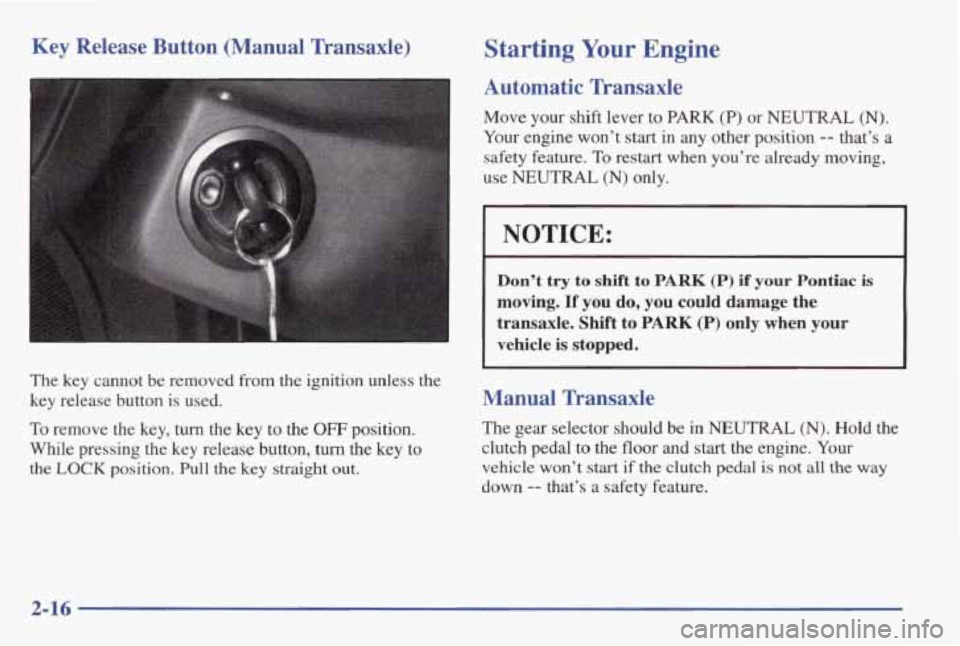
Key Release Button (Manual Transaxle)
The key cannot be removed from the ignition unless the
key release button is used.
To remove the key, turn the key to the OFF position.
While pressing the
key release button, turn the key to
the LOCK position. Pull the key straight out.
Starting Your Engine
Automatic Transaxle
Move your shift lever to PARK (P) or NEUTRAL (N).
Your engine won’t start in any other position -- that’s a
safety feature.
To restart when you’re already moving,
use
NEUTRAL (N) only.
I NOTICE:
Don’t try to shift to PARK (P) if your Pontiac is
moving. If you do, you could damage the
transaxle.
Shift to PARK (P) only when your
vehicle is stopped.
Manual Transaxle
The gear selector should be in NEUTRAL (N). Hold the
clutch pedal to
the floor and start the engine. Your
vehicle won’t
start if the clutch pedal is not all the way
down
-- that’s a safety feature.
2-16
Page 78 of 370
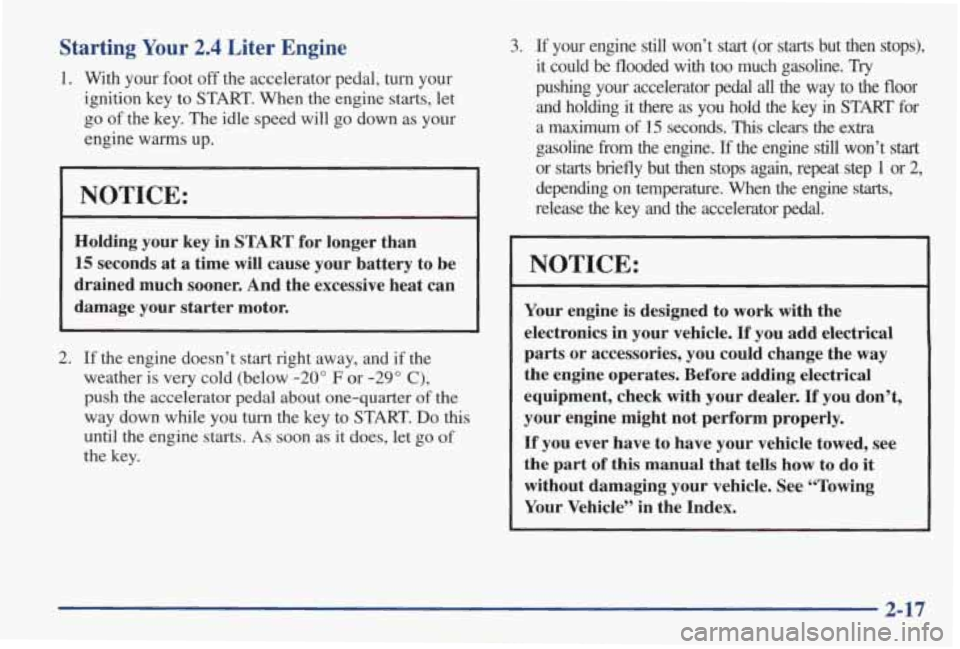
Starting Your 2.4 Liter Engine
1. With your foot off the accelerator pedal, turn your
ignition key
to START. When the engine starts, let
go of the key. The idle speed will go down as your
engine warms up.
I I
NOTICE:
Holding your key in START for longer than
15 seconds at a time will cause your battery to be
drained much sooner. And the excessive heat can
damage your starter motor.
2. If the engine doesn’t start right away, and if the
weather is
very cold (below -20” F or -29” C),
push the accelerator pedal about one-quarter of the
way down while you
turn the key to START. Do this
until the engine starts. As soon as it does, let go of
the key.
3. If your engine still won’t start (or starts but then stops),
it could
be flooded with too much gasoline. Try
pushing your accelerator pedal all the way to the floor
and holding it there as you hold the key in START for
a
maximum of 15 seconds. This clears the extra
gasoline
from the engine. If the engine still won’t start
or starts briefly but then stops again, repeat step 1 or 2,
depending on temperature. When the engine starts,
release the key and the accelerator pedal.
NOTICE:
Your engine is designed to work with the
electronics in your vehicle.
If you add electrical
parts or accessories, you could change the way
the engine operates. Before adding electrical
equipment, check with your dealer.
If you don’t,
If you ever have to have your vehicle towed, see
the part of this manual that tells how to do it
without damaging your vehicle. See “Towing
Your Vehicle” in the Index.
~ your engine might not perform properly.
2-17
Page 79 of 370

Starting Your 3100 Engine
1. Without pushing the accelerator pedal, turn your
ignition key to START. When the engine starts, let
go
of the key. The idle speed will go down as your
engine gets warm.
NOTICE:
Holding your key in START for longer than
15 seconds at a time will cause your battery to be
drained much sooner. And the excessive heat can
damage your starter motor.
2. If your engine won’t start (or starts but then stops), it
could be
flooded with too much gasoline. Try
pushing your accelerator pedal all the way to the
floor and
holding it there as you hold the key in
START for up to 15 seconds. This clears the extra
gasoline
from the engine.
NOTICE:
Your engine is designed to work with the
electronics
in your vehicle. If you add electrical
parts
or accessories, you could change the way
the engine operates. Before adding electrical
equipment, check with
your dealer. If you don’t,
your engine
might not perform properly.
If you ever have to have your vehicle towed, see
the part of this manual that tells how to do it
without damaging your vehicle. See “Towing
Your Vehicle” in the Index.
2-18
Page 83 of 370
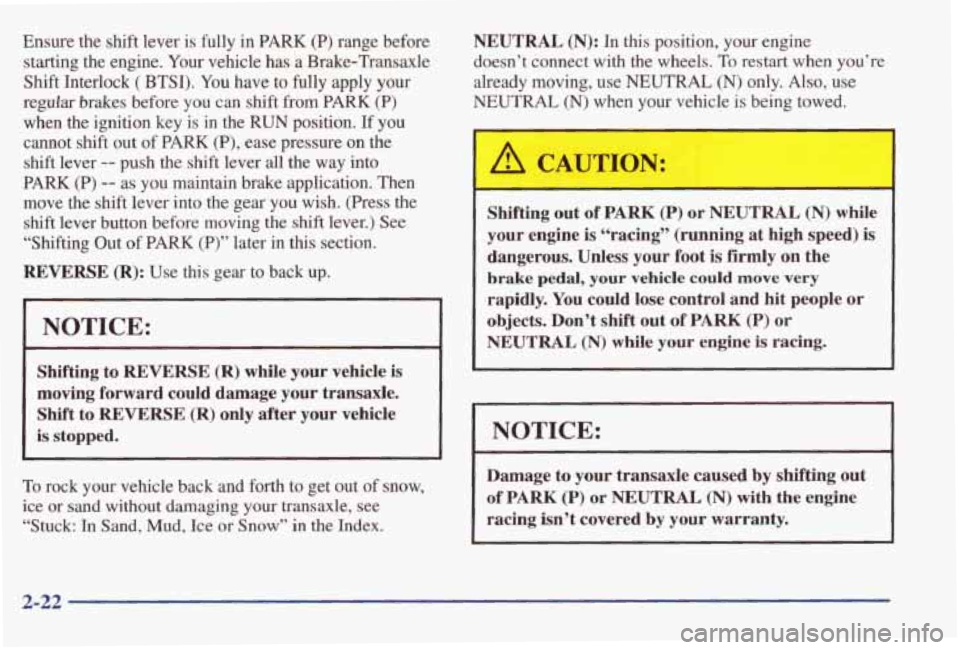
Ensure the shift lever is fully in PARK (P) range before
starting the engine. Your vehicle has a Brake-Transaxle
Shift Interlock
( BTSI). You have to fully apply your
regular brakes before you can shift from PARK (P)
when the ignition key is in the RUN position. If you
cannot
shift out of PARK (P), ease pressure on the
shift lever
-- push the shift lever all the way into
PARK (P) -- as you maintain brake application. Then
move the shift lever into the gear you wish. (Press the
shift lever button before moving the shift lever.) See
“Shifting Out of
PARK (P)” later in this section.
REVERSE (R): Use this gear to back up.
I 1
NOTICE:
Shifting to REVERSE (R) while your vehicle is
moving forward could damage
your transaxle.
Shift to REVERSE (R) only after your vehicle
is stopped.
To rock your vehicle back and forth to get out of snow,
ice or sand without damaging your transaxle, see
“Stuck: In Sand, Mud, Ice
or Snow” in the Index.
NEUTRAL (N): In this position, your engine
doesn’t connect with the wheels.
To restart when you’re
already moving, use
NEUTRAL (N) only. Also, use
NEUTRAL (N) when your vehicle is being towed.
I
Shifting out of PARK (P) or NEUTRAL (N) while
your engine is “racing” (running at high speed) is
dangerous. Unless your foot is firmly on the
brake pedal, your vehicle could move very
rapidly. You could lose control and hit people or
objects. Don’t shift out of PARK (P) or
NEUTRAL (N) while your engine is racing.
NOTICE:
Damage to your transaxle caused by shifting out
of PARK (P) or NEUTRAL (N) with the engine
racing isn’t covered
by your warranty.
2-22 -~
Page 88 of 370

Parking Brake
To set the parking brake, hold the regular brake pedal
down
with your right foot. Pull up on the parking brake
handle. If the ignition is on, the brake system warning
light will come on.
To release the parking brake, hold the regular brake
pedal down. Pull the parking brake lever up until you
can press the release button. Hold the release button in as you move the brake lever all the way down.
Driving with the parking brake on can cause
your rear brakes to overheat. You may have to replace them, and you could also damage other
parts
of your vehicle.
If you are towing a trailer and are parking on any hill,
see “Towing a Trailer” in the Index. That section shows
what to do first to keep the trailer from moving.
2-27
Page 89 of 370
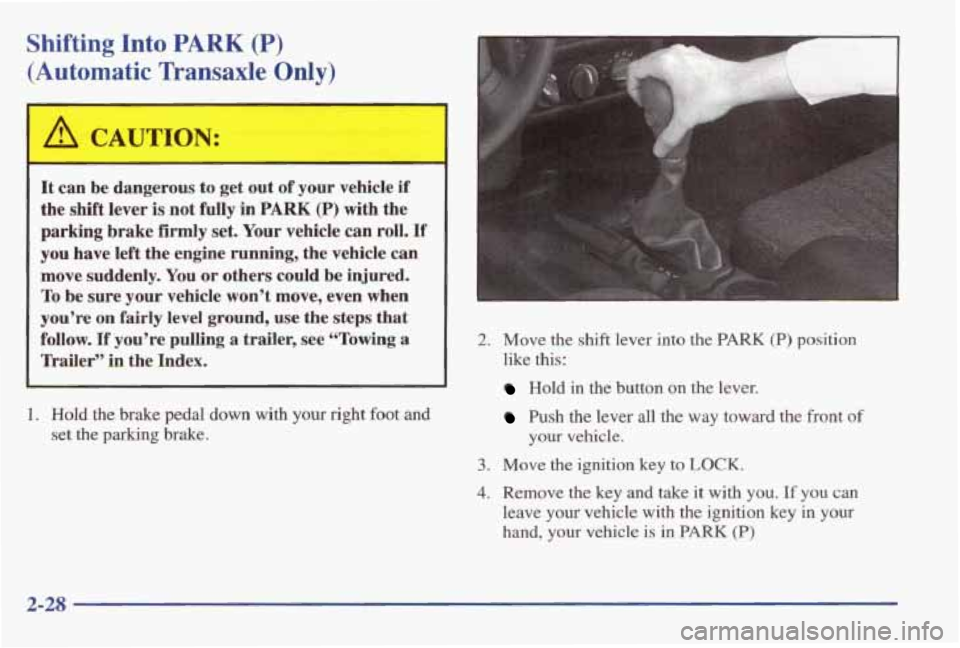
Shifting Into PARK (P)
(Automatic Transaxle Only)
A CAUTION:
It can be dangerous to get out of your vehicle if
the shift lever is not fully in PARK (P) with the
parking brake firmly set. Your vehicle can
roll. If
you have left the engine running, the vehicle can
move suddenly. You or others could
be injured.
To be sure your vehicle won't move, even when
you're on
fairly level ground, use the steps that
follow.
If you're pulling a trailer, see "Towing a
Tkailer" in the Index.
i
1. Hold the brake pedal down with your right foot and
set the parking brake.
2. Move the shift lever into the PARK (P) position
like this:
Hold in the button on the lever.
Push the lever all the way toward the front of
your
vehicle.
3. Move the ignition key to LOCK.
4. Remove the key and take it with you. If you can
leave your vehicle with the ignition key in your
hand, your vehicle is in
PARK (P)
2-28
Page 91 of 370
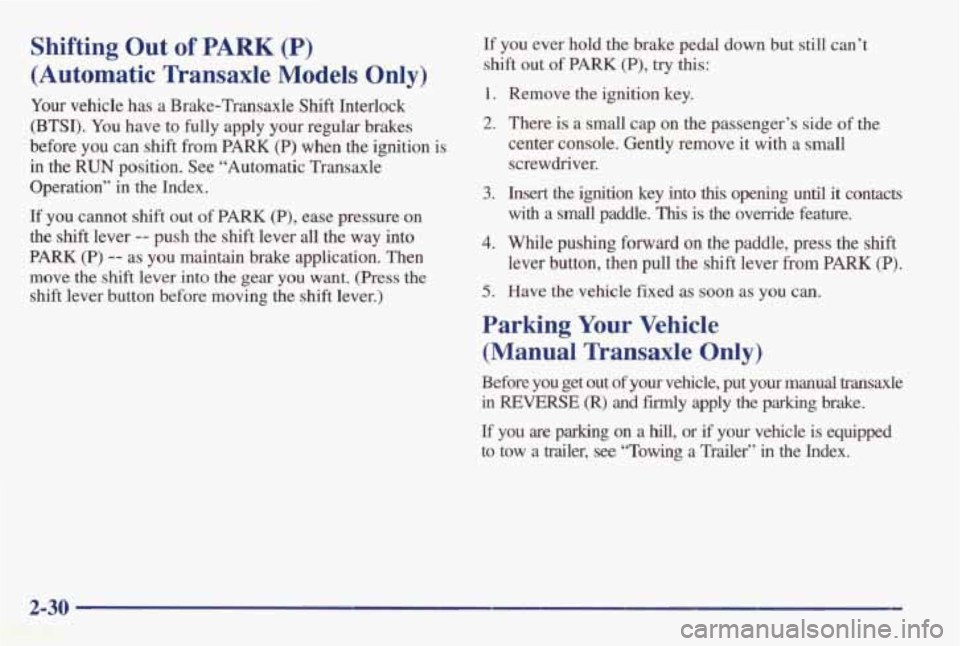
Shifting Out of PARK (P)
(Automatic Transaxle Models Only)
Your vehicle has a Brake-Transaxle Shift Interlock
(BTSI). You have to
fully apply your regular brakes
before you can shift from PARK
(P) when the ignition is
in the
RUN position. See “Automatic Transaxle
Operation” in the Index.
If you cannot shift out of PARK (P), ease pressure on
the
shift lever -- push the shift lever all the way into
PARK (P) -- as you maintain brake application. Then
move the shift lever into the gear you want. (Press the
shift lever button before moving the shift lever.) If you
ever hold the brake pedal down
but still can’t
shift out of
PARK (P), try this:
1. Remove the ignition key.
2. There is a small cap on the passenger’s side of the
center console. Gently remove it
with a small
screwdriver.
3. Insert the ignition key into this opening until it contacts
with a small paddle. This is the override feature.
4. While pushing forward on the paddle, press the shift
lever button, then pull the shift lever from PARK (P).
5. Have the vehicle fixed as soon as you can.
Parking Your Vehicle
(Manual Transaxle Only)
Before you get out of your vehicle, put your manual transaxle
in REVERSE (R) and firmly apply the parking brake.
If you are parking on a hill, or if your vehicle is equipped
to tow a trailer, see “Towing a Trailer’’ in the Index.
2-30
Page 94 of 370
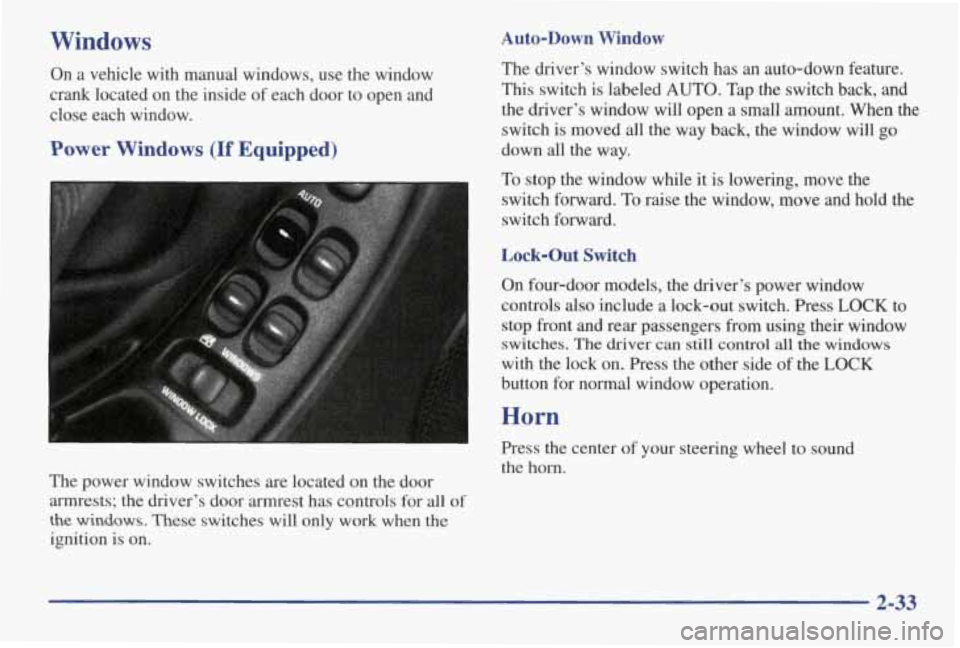
Windows
On a vehicle with manual windows, use the window
crank located on the inside of each door to open and
close each window.
Power Windows (If Equipped)
The power window switches are located on the door armrests; the driver’s door armrest has controls for all
of
the windows, These switches will only work when the
ignition is on.
Auto-Down Window
The driver’s window switch has an auto-down feature.
This switch is labeled
AUTO. Tap the switch back, and
the driver’s window will open a small amount. When the
switch is moved all the way back, the window will go
down all the way.
To stop the window while it is lowering, move the
switch forward.
To raise the window, move and hold the
switch forward.
On four-door models, the driver’s power window
controls
also include a lock-out switch. Press LOCK to
stop front
and rear passengers from using their window
switches.
The driver can still control all the windows
with the lock on. Press the other side of the LOCK
button for normal window operation.
Horn
Press the center of your steering wheel to sound
the
horn.
2-33
Page 102 of 370

Reducing Speed While Using Cruise Control
There are two ways to reduce your speed while using
cruise control:
0 Press in the button at the end of the lever until you
reach the lower speed you want, then release it.
To slow down in very small amounts, push the
button for less than half a second. Each time you
do
this, you’ll go 1 mph (1.6 km/h) slower.
Passing Another Vehicle While Using Cruise Control
Use the accelerator pedal to increase your speed. When
you take your foot
off the pedal, your vehicle will slow
down to the cruise control speed you set earlier.
Using Cruise Control on Hills
How well your cruise control will work on hills depends
upon your speed,
load, and the steepness of the hills.
When going up steep hills, you may have to step
on the
accelerator pedal to maintain your speed. When going
downhill, you may have to brake or shift to a lower gear
to keep your speed down.
Of course, applying the brake
takes you out of cruise control. Many drivers find
this to
be too much trouble and don’t use cruise control on
steep hills.
Ending Cruise Control
There are two ways to turn off the cruise control:
0 Step lightly on the brake pedal or push the clutch
pedal, if you have a manual transaxle: or
0 Move the cruise switch to OFF.
Erasing Cruise Speed Memory
When you turn off the cruise control or the ignition,
your cruise control
set speed memory is erased.
2-41
Page 103 of 370
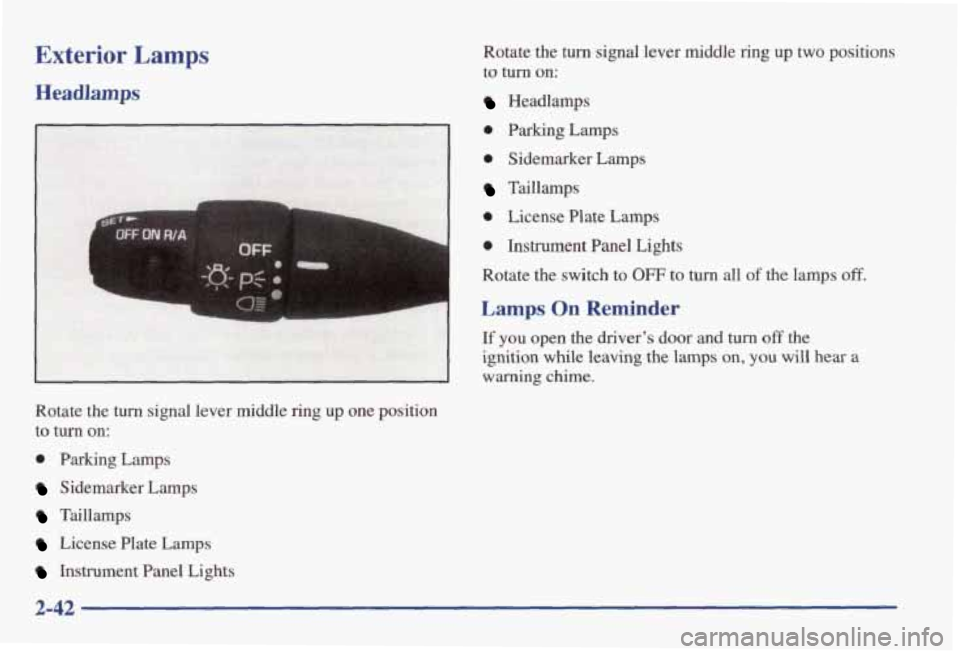
Exterior Lamps
Headlamps
Rotate the turn signal lever middle ring up one position
to
turn on:
0 Parking Lamps
Sidemarker Lamps
Taillamps
License Plate Lamps
Instrument Panel Lights Rotate the
turn signal lever middle ring up two positions
to
turn on:
Headlamps
0 Parking Lamps
0 Sidemarker Lamps
Taillamps
0 License Plate Lamps
0 Instrument Panel Lights
Rotate the switch to OFF to turn all of the lamps off.
Lamps On Reminder
If you open the driver's door and turn off the
ignition while leaving the lamps on, you will hear a
warning chime.
2-42